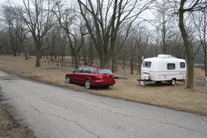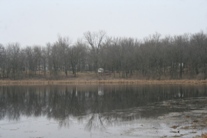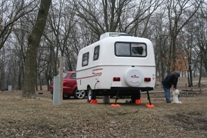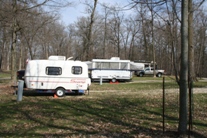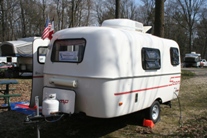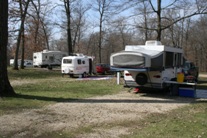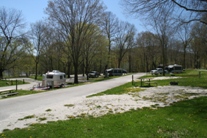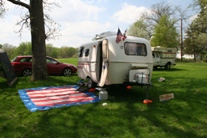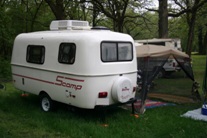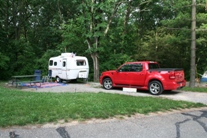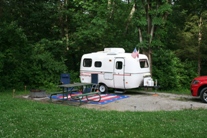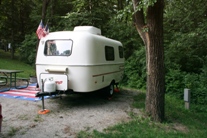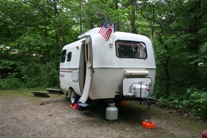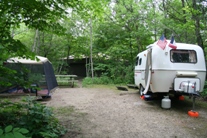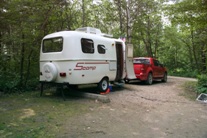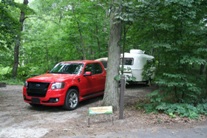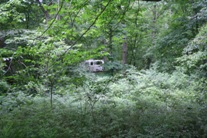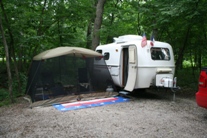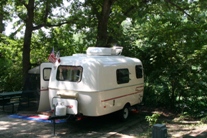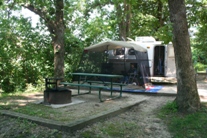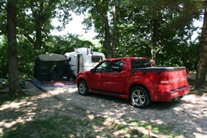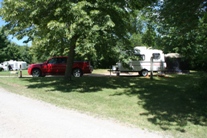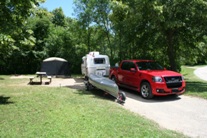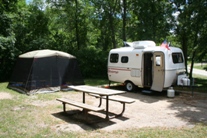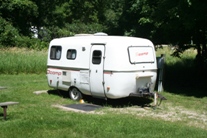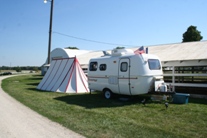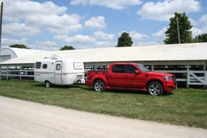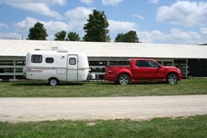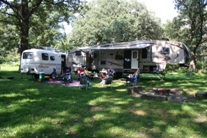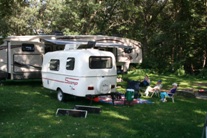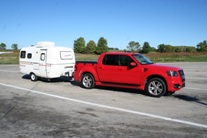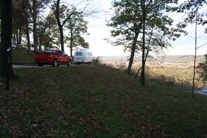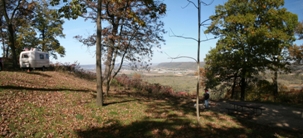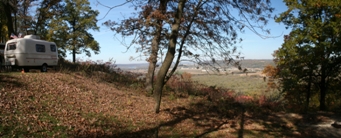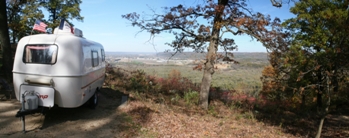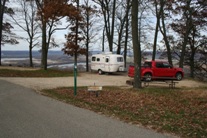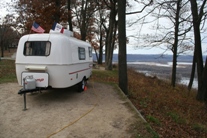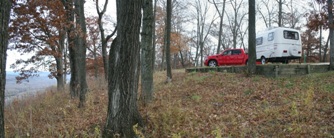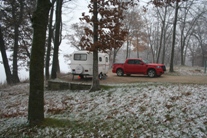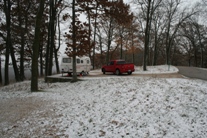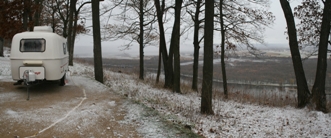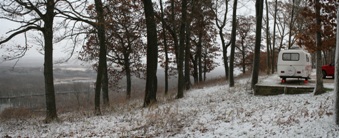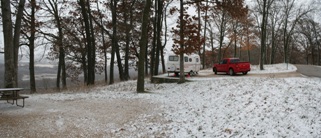Scamp Photo Album 2013
(Click Thumbnails for Larger Picture)
|
The
first outing of the year, first weekend in April,
while looked forward to, did not go as well as we
had hoped. The weather was predicted to be a
bit warmer than it turned out to be, but we still
had a good time. We always like to get an
early start to the year anyway, that way we can work
any issues with the camper out before we start with
the heavy camping schedule. This year we only
forgot a few items, and we were close enough to home
to pick them up when we stopped by.
I
would like to mention a couple of tips about camping
this early in the season. It may seem like a
good idea to de-winterize your water system, but
remember that most of the tanks, lines, and hoses
are near the outside, if not outside, the camper and
can be susceptible to cold nights. We usually
wait until the middle or late April before flushing
all of the lines. Also, while the campgrounds
might be open and have the electricity turned on,
most parks do not turn the water on until the middle
of May. This also means that the bathrooms
will be closed, unless they are the vault type
restroom facilities. It is always a good idea
to check the park's website, or contact the park
directly.
|
(Click Thumbnails for Larger Picture)
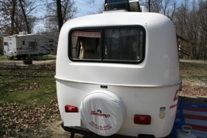
|

|
|
Our
second outing of the year was to Backbone State Park
in Iowa. It was a camping group get together
with friends and family. As you can see in the
photos, that besides our group, there were quite a
few other campers braving the Iowa spring weather.
There are a couple of things I wanted to point out
in the photos above. First, you will notice
the sign in the front window of the camper.
This was the prototype camp sign that Lisa came up
with last fall. We have been mulling the idea
over for a couple of years now, and she finally put
something on paper when we were in Gettysburg.
We let the idea simmer all winter and we have
decided that this will be the sign. As this is
being written, the sign is nearly complete and will
be ready for our next outing.
Secondly, I wanted to point out the last two
pictures in the series. I was walking behind
the trailer when I happened to look in the back
window. I know that people think these campers
are small from the outside, but looking in the back
window, through the camper all the way to the front,
it really does open up and reveal there is more room
than one would think.
|
(Click Thumbnails for Larger Picture)
|
Mother's Day weekend, we headed to Dolliver State
Park in Iowa. While the weather was nicer than
the first outing, it was cooler and windier than the
second. One thing I noticed this weekend is
that the wind does not affect the camper nearly as
much it did other campers in the park. The
round form of the camper does a good job of
deflecting the wind, and the R-15 insulation keeps
the temperature fluctuation to a minimum.
This
weekend trip was also the debut of the official
camping sign of the Dampened Enthusiasts. We
have been wanting to create a sign for our campsites
for some time now, and I believe we have hit on the
perfect design.
|
(Click Thumbnails for Larger Picture)
|
The
photos above are from the last two weekends in May.
The first two are of an unofficial SCA gathering we
attended once a year called St. Augustine's
Un-Faire. Although it is a Middle Ages themed
event, we use the Scamp as a place holder. We
usually come out a couple of days in advance and get
a spot, and with the Scamp, we can lock it during
the day when we are gone.
The
last three photos in the series are from the
Memorial Day campout that we usually hold. We
had the same site as the previous weekend, but a
different location. Nice thing about the Scamp
is it can fit into spaces many campers cannot.
This was fairly uneven ground with very little room
to maneuver a car out of the way once you unhook.
Also, the ground was wet the day we packed up and
other vehicles had problems with the wet ground.
The Scamp was light enough that it was fairly easy
to move around in these conditions.
|
(Click Thumbnails for Larger Picture)
|
This
was our first trip to Lake MacBride State Park just
south of Cedar Rapids, Iowa. You will notice a
different tow vehicle than we have used in the
past. Just after our Memorial Day camping trip, we
discovered that our Mazda truck was in worse shape
than it appear on the surface. So we decided
to start looking for a new truck, since they are
really handy to have for hauling, towing, etc.
After inquiring with our usual car dealer, it just
so happened that this truck had just been traded in.
So recently, in fact, that the morning we drove down
to look at it, it had just come back from the
detailers. Well, to make a long story short,
we had been looking for this model of truck, and
with Ford discontinuing the model in 2010, we
decided we better get it while we could. The
decision was a sound one, and one I have yet to
regret.
Now,
a little about towing with the new truck. Our
first trip was the second week of June to Missouri for
an SCA re-enacting event. The covered wagon,
that we use for that trip, pulled so nice, I hardly
even knew it was behind us. For this trip with
the Scamp, it was the same. Even though the
truck is larger than our car, and came with a
complete Class III/IV towing package, it still really
felt good to have the electric brakes on the
trailer. The trailer also did not sway or
bounce around like it did with the car, and when we
arrived at camp, it was far easier to control when
backing in to our site. After looking inside
the the trailer, I noticed
that the contents were not jumbled around nearly as much as when we used the car.
I do
not want to discourage people who have smaller
vehicles from using them to tow a
Scamp. There are many advantages to small car
towing. Better gas mileage when not towing, no
need to store a larger vehicle when not using it to
tow, and generally a more comfortable ride when
exploring the areas you are visiting. What I
would like to stress is that with smaller vehicle,
you need to pay a lot closer attention to driving
when towing. You need to give yourself more
time to stop, you need to pay attention to wind
conditions, you need to learn to accelerate more
gently, and you really must pay attention to
the tongue weight of the trailer. Getting the
tongue weight down to fifteen percent of the trailer
will make more of a difference in towing with a
smaller car verses a bigger vehicle.
Also, regardless of what type of vehicle you use
when towing, you want to keep up with the regular
maintenance on your vehicle. It has also been
suggested that you increase the amount of
maintenance, above and beyond the recommended
maintenance, that your tow vehicle should get.
This will help to ensure that you catch any
potential problems with the vehicle before you find
yourself in trouble on the highway, as well as
prolonging the life of your vehicle.
If
you have any more questions or concerns about
towing, please feel free to contact us at
Information@dampenedenthusiasts.com.
|
(Click Thumbnails for Larger Picture)
|
This
was the first time we have been back to Great River
Bluffs campground in Minnesota in five years.
The last time we were here was the Fourth of July in
2008. That was also the last time we went tent
camping. Within a few weeks of that trip, we
were the proud owners of a new Scamp.
I
did learn a few things about camping at this
campground with the Scamp. It has a lot of
nice shade, but unfortunately, I did not judge where
the sun was going to be very well. I put the solar panels
out in the sun and set up the screen tent in the
shade, but it was late afternoon on the first day of
camp when I did that. Well, it turned out that the tent was in
the spot that got the most sun, and the solar panels
were in the location that got the most shade. Unfortunately, we spend most of the afternoons out
and about and did not notice the sun/shade pattern
until late on the last day of camp. This
caused a little problem with the batteries as
they were not getting a good charge from the panels
during the day.
If you want to camp off grid and use solar panels
like we do, it is very important to find out, early
on, where the best sun is going to be for the
panels. The good thing about this is that I
finally decided to pick up a small solar panel for
the "portable", or extra, marine battery that we
bring along, so we can keep that charge that as well.
One
other thing that I would like to point out is the
screen tent that we use. We had considered an
awning for the Scamp when we purchased it, but
eventually decided against it due to weight
restrictions. I was trying to keep the weight
down to make it easier for pulling with the car.
While there have been a time or two when an awning
would have been nice, we decided we liked the screen
tent better. It can be put up anywhere around
camp and does not have to be right next to the
trailer. Also, the screen part of the tent
allows us a good view of the area around camp, and
does a really good job keeping the bugs away.
It is also light weight and does keep the rain out
as long as it is not a torrential downpour.
Just something to consider if you are thinking about
any type of camper.
|
(Click Thumbnails for Larger Picture)
|
Here
we are back in Ledges State Park. We found a
little loop that was a bit more private nestled
amongst the trees. I may have mentioned this
before, but I wanted to do it again for emphasis.
We did not get the awning for the Scamp and decided
to use our screened in tent when we needed shade.
It is also really great for insect control as well.
The nice thing about it, you can place it anywhere
and do not always have to be right up against the
trailer.
|
(Click Thumbnails for Larger Picture)
|
We
decided to take a little time off to find a campsite
along the Mississippi River in July, but
unfortunately, the water was still too high at this
time of the year. None of the campgrounds,
that were first come first serve only, were open, so
we returned to Pikes Peak. It was also a hot
weekend and the air conditioner really came in
handy. You can also see by the photos that
having a smaller trailer can be very advantageous
when you are dealing with sites that tend to be on
the small side. Even with the truck, camper,
and tent up, we still had enough room for a
campfire.
|
(Click Thumbnails for Larger Picture)
|
Traveling back to Myre-Big Island State Park in
Minnesota, we chose to state in the Whitefox
Campground instead of the Island Campground.
Very nice fit for the trailer and the lake was just
beyond the trees behind the trailer. We also
found another Scamp in the campground, something
that seems to be a rare find this year for some
reason.
|
(Click Thumbnails for Larger Picture)
|
This
time we were traveling back in time, so to speak.
We were camping medieval style for our SCA group at
the Floyd County Fair Grounds, in Charles City,
Iowa. The tent behind the trailer is ours as
well. We set it up for family members who join
us for this event. This was the first time I
had a chance to get a picture of the new truck
pulling the Scamp.
The decision to purchase
the truck for pulling the trailer is really working
out well. I would like to pass along some
advice about towing a trailer that I learned, and it
applies to any vehicle used for towing. If you
have the option to turn the overdrive off, I would
suggest doing so. It may decrease your gas
mileage, but the transmission will run a bit
smoother if it is not downshifting all of the time.
One
thing I would like to add about small vehicle
towing, actually saw something I have only seen in
pictures: a new style Volkswagon Beetle towing a 13
Foot Scamp. I was debating getting a picture
of it, but I was driving and I could not get back
around in time to take a photo. If you do have
photos of Scamps being towed, or interesting Scamp
photos and would like to share them, please feel
free to email them to
information@dampenedenthusiats.com.
|
(Click Thumbnails for Larger Picture)
|
Labor Day came around way too fast this year.
It was a wonderful weekend, even though the weather
was predicted to be dreadful. While we really
enjoy the compact size of the Scamp, there are many
different types of camping units. The large
unit in the background belongs to relatives of ours
(they had just purchased it), and this was only the
second outing for it. They are planning on
traveling quite a bit when they retire, and this is
the perfect unit for them.
|
(Click Thumbnails for Larger Picture)
|
The
start of our fall trip. This was the first
time we took the new truck on a long distance hall.
Of course, I'm not too sure if a six hour drive is
considered long distance. We headed up to the
North Shore of Lake Superior for the week. I
decided about halfway there to leave the overdrive
engaged on the truck to see if it did make any
difference in mileage. It does make a slight
difference and I do get a bit better mileage with
the overdrive engaged. With the trailer being
so light weight, the only time I really need to turn
the overdrive off is in areas where the terrain
rises and falls a considerable amount.
Otherwise, the truck turns out to be a really good
and reliable vehicle for this type of trip.
|
(Click Thumbnails for Larger Picture)
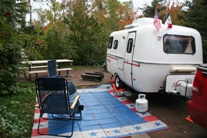
|

|
|
We
had a fairly nice site for our fall trip.
While I was hoping to get a site right along the
lake, those sites were reserve by the time I tried
to reserve. This site was a bit higher, but
you could see a little of the lake through the
trees. It was also fairly close to the beach
so you could walk down and enjoy some time listening
to the waves.
In
the picture on the left, you will see an additional
solar panel. I picked that up this summer for
our extra battery. We have a second battery to
run some of the load and it is portable so we can
move it around site if we want to sit outside.
Earlier this summer, we ended up draining that
battery and I did not have a way to recharge it,
other than the battery charger at home. So I
picked the smaller one up for it. I did find a
way to charge the spare battery using the truck.
I have a cable that I can plug into an accessory
outlet in the truck, then connect it to the battery
and charge it while we are out sight seeing.
That works really well. Since I can do that, I
took the smaller panel and added it to the array of
panels I already have.
I
would like to point out a couple of power issues we
had during this trip. We are both on call for
our jobs, even on vacation, and rely on our cell
phones. We usually charge the phones from the
batteries we have, but this trip, the coverage was
spotty at best. We ended up using the booster
we have, but unfortunately, that draws a constant
0.5 Amp charge. Even though we turned it off
when we were gone, we had to run it at night and it
drained the trailer's battery pretty fast. We
also had fog for nearly three days solid, so the
panels were not getting direct sunlight. I
ended up plugging the trailer into the truck and let
the truck run for a bit to recharge the trailer
battery. I do not like to leave the truck
running, but as a last resort option, it worked
really well. During all of this, I did
discover that our lights were drawing a whopping 1.5
Amp charge for each light. For that fix, I
decided to look at LED bulbs. I have that
description below.
|
(Click Thumbnails for Larger Picture)
|
Despite the high water and park closures, we managed
to make it to Merrick State Park in Wisconsin.
While the wind was a bit brisk, the sun was very
warm. We even managed to get out on the river
in my brother's boat. Getting back was a bit
of a challenge, since the motor failed and we ended
up push-poling the boat about a mile up river
against the wind and current.
|
(Click Thumbnails for Larger Picture)
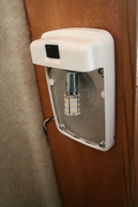
|
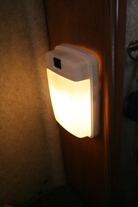
|

|
|
To
help solve the problem of drawing our battery down
too quickly, I explored the option of LED
replacement bulbs. The bulbs that came with i
the trailer were a standard 1141 12 volt incandescent bulb.
Unfortunately, they tend to draw quite a bit of
electricity and put out a staggering amount of heat.
Even so, I was not too sure if I wanted to do this, because LEDs have been known to be too bright, to white, or
do not put enough light out. I found these
bulbs on Amazon and they are designed by BrightTech.
As you can see in the first picture, they are six
panels with six LEDs each. They are not flat
panels as some replacements are. When turned
on, you can see that it is a soft, warm light just
like an incandescent bulb would be. You can
see what an incandescent bulb looks like turned on in the last
picture.
This
is what I have discovered about the operation of
theses bulbs. The first weekend we used them,
we could not tell the difference between the light
output of the incandescents verses the LED.
Secondly, they did not put out any heat, so you do
not have to worry about accidentally burning
yourself on the cover. And lastly, the best
part, is that one bulb only draws around 0.1 to 0.2
Amps of electricity. A huge difference over
the incandescents. When I checked the Amp draw
with the three bulbs I purchased, it was only about
0.4 to 0.5 Amp total. The same amount of
incandescent bulbs were pulling 5 plus Amps.
Also, when I ran the water pump for the sink, the
light with the LED bulb did not flicker at all.
I only purchased three
bulbs for this trip, but I will be replacing the
remaining ones with LEDs. The only
ones I won't are the outside light, and the two
swivel lights over the bed. Those do not have
decent covers to defuse the light properly, and that
is something you really need to consider when
exploring the option of LED bulbs.
|
(Click Thumbnails for Larger Picture)
|
Wrapping up the regular camping season at Wyalusing
State Park in Wisconsin. The view is always
spectacular from this campground and we are
determined to visit during the regular season, but
visiting in the fall is a great, and colorful way,
to end the season. While we may be done
camping on a regular basis, I am still hoping to do
some winter camping this year. With luck a
November trip may be in the planning, and from there
we will see.
The
final photos of this series are some panoramic shots
that I created using panoramic stitching software I
have been experimenting with. I really like
the end results because it gives you a greater field
of view, and a feel of what it was like to be there.
|
(Click Thumbnails for Larger Picture)
|
We
finally tried camping in November, and ironically
enough, it was Wyalusing once again. We had an
extended weekend and decided to take advantage of
the fairly decent weather for November. The
wind was very strong the first night here, but it
calmed down by the next day. The trailer did a
wonderful job staying warm and did not shake from
the gusting wind. While I had already
winterized the water system, we did bring along a
container of water for the trip. It was nice
to discover that the campground does have one
winterized spigot for winter campers, but I would
always recommend starting out from home with you own
container of water.
While we are done with the regular camping season, I
am hoping to get out one more time before the end of
the year, and since the camper works so well in the
cold weather, I am hoping to get one or two winter
trips in before next spring. Check back to see
if we eventually get to try winder camping.
|
(Click Thumbnails for Larger Picture)
|
I
should not have spoken too soon about winter
camping. I posted the previous set of photos
at the end of the first day of camping at
Wyalusing State Park. The photos above were
taken the second day of camping. While it was
cold and windy, temp down in the lower twenties to
high teens, the Scamp did a wonderful job of keeping
us warm. The furnace only kicked in about once
an hour or so, much like a home furnace does.
I definitely would like to try true winder camping
after this weekend.
|
If you would like better quality copies of the photos, or would like more
information about places we have been, please feel free to contact us
at
Information@dampenedenthusiasts.com
or
russ@dampenedenthusiasts.com.
|

